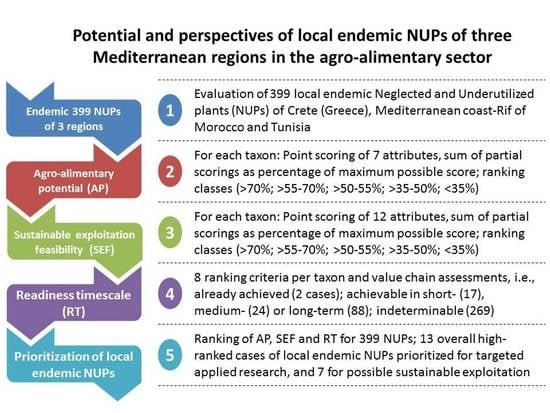Agro-Alimentary Potential of the Neglected and Underutilized Local Endemic Plants of Crete (Greece), Rif-Mediterranean Coast of Morocco and Tunisia: Perspectives and Challenges
Abstract
:1. Introduction
2. Results
2.1. Cluster Analysis of Agro-Alimentary Attributes and of Focal Taxa
2.2. Diversity of Local Endemic NUPs
2.3. Agro-Alimentary Potential of the Focal Local Endemic NUPs
2.3.1. Local Endemic Plants of Crete
2.3.2. Local Endemic Plants of the Mediterranean Coast-Rif of Morocco
2.3.3. Local Endemic Plants of Tunisia
3. Discussion
3.1. Agro-Alimentary Potential of the Studied Local Endemic NUPs
3.2. Sustainable Exploitation Feasibility of the Focal NUPs in the Agro-Alimentary Sector
3.3. Readiness Timescale for Sustainable Exploitation of the Focal NUPs in the Agro-Alimentary Sector
4. Materials and Methods
4.1. Study Area and Target-Plants
4.2. Methodological Scheme Applied
4.3. Evaluation Levels
4.4. Statistical Analysis
5. Conclusions
Supplementary Materials
Author Contributions
Funding
Data Availability Statement
Acknowledgments
Conflicts of Interest
References
- RBG. The State of the World’s Plants Report 2016; Royal Botanic Gardens: Kew, UK, 2016; Available online: https://stateoftheworldsplants.org/2016/report/sotwp_2016.pdf (accessed on 6 February 2021).
- Collins, W.W.; Hawtin, G.C. Conserving and using crop plant biodiversity in agroecosystems. In Biodiversity in Agroecosystems; Collins, W.W., Qualset, C.O., Eds.; CRC Press: London, UK, 1998; Volume 2, pp. 215–236. [Google Scholar]
- FAO. Promoting Neglected and Underutilized Crop Species. 2017. Available online: http://www.fao.org/news/story/en/item/1032516/icode/ (accessed on 5 February 2021).
- Khabbach, A.; Libiad, M.; Ennabili, A. Plant resources use in the Province of Taza (North of Morocco). ProEnvironment 2011, 4, 347–356. [Google Scholar]
- Libiad, M.; Khabbach, A.; Ennabili, A. Exploitation of plants from upstream of the Sebou-wadi watershed (Province of Taounate, North of Morocco). Biol. Divers. Conserv. 2011, 4, 81–91. [Google Scholar]
- Godfray, H.C.J.; Beddington, J.R.; Crute, I.R.; Haddad, L.; Lawrence, D.; Muir, J.F.; Pretty, J.; Robinson, S.; Thomas, S.M.; Toulmin, C. Food security: The challenge of feeding 9 billion people. Science 2010, 327, 812–818. [Google Scholar] [CrossRef] [PubMed] [Green Version]
- IPGRI. Neglected and Underutilized Plant Species: Strategic Action Plan of the International Plant Genetic Resources Institute; International Plant Genetic Resources Institute: Rome, Italy, 2002; ISBN 92-9043-529-1. [Google Scholar]
- Padulosi, S.; Thompson, J.; Rudebjer, P. Fighting Poverty, Hunger and Malnutrition with Neglected and Underutilized Species (NUS): Needs, Challenges and the Way Forward; Bioversity International: Rome, Italy, 2013; p. 56. ISBN 978-92-9043-941-7. [Google Scholar]
- Dansi, A.; Vodouhe, R.; Azokpota, P.; Yedomonhan, H.; Assogba, P.; Adjatin, A.; Loko, I.Y.; Dossou-Aminon, I.; Akpagana, K. Diversity of the neglected and underutilized crop species of importance in Benin. Sci. World J. 2012, 2012, 1–19. [Google Scholar] [CrossRef] [PubMed] [Green Version]
- Ebert, A.W. Potential of underutilized traditional vegetables and legume crops to contribute to food and nutritional security, income and more sustainable production. Sustainability 2014, 6, 319–335. [Google Scholar] [CrossRef] [Green Version]
- Padulosi, S.; Mal, B.; King, I.O.; Gotor, E. Minor millets as a central element for sustainably enhanced incomes, empowerment, and nutrition in rural India. Sustainability 2015, 7, 8904–8933. [Google Scholar] [CrossRef] [Green Version]
- Padulosi, S.; Cawthorn, D.M.; Meldrum, G.; Flore, R.; Halloran, A.; Mattei, F. Leveraging neglected and underutilized plant, fungi, and animal species for more nutrition sensitive and sustainable food systems. Encycl. Food Secur. Sustain. 2019, 3, 361–370. [Google Scholar] [CrossRef]
- Pieroni, A.; Hovsepyan, R.; Manduzai, A.K.; Sõukand, R. Wild food plants traditionally gathered in central Armenia: Archaic ingredients or future sustainable foods? Environ. Dev. Sustain. 2020, 23, 2358–2381. [Google Scholar] [CrossRef]
- Neupane, B.; Poudel, S. Documentation and on farm conservation of neglected and underutilized plant species in Lamjung district, Nepal. Heliyon 2021, 7, e05887. [Google Scholar] [CrossRef]
- Chivenge, P.; Mabhaudhi, T.; Modi, A.T.; Mafongoya, P. The potential role of neglected and underutilised crop species as future crops under water scarce conditions in sub-Saharan Africa. Int. J. Environ. Res. Public Health 2015, 12, 5685–5711. [Google Scholar] [CrossRef] [Green Version]
- Raimundo, J.R.; Frazão, D.F.; Domingues, J.L.; Quintela-Sabaris, C.; Dentinho, T.P.; Anjos, O.; Alves, M.; Delgado, F. Neglected Mediterranean plant species are valuable resources: The example of Cistus ladanifer. Planta 2018, 248, 1351–1364. [Google Scholar] [CrossRef] [PubMed]
- Conti, M.V.; Campanaro, A.; Coccetti, P.; De Giuseppe, R.; Galimberti, A.; Labra, M.; Cena, H. Potential role of neglected and underutilized plant species in improving women’s empowerment and nutrition in areas of sub-Saharan Africa. Nutr. Rev. 2019, 77, 817–828. [Google Scholar] [CrossRef] [PubMed]
- Stockes, D.L. Why conserving species in the wild still matters. Biodivers. Conserv. 2018, 27, 1539–1544. [Google Scholar] [CrossRef]
- Bacchetta, G.; Farris, E.; Pontecorvo, C. A new method to set conservation priorities in biodiversity hotspots. Plant Biosyst. 2012, 146, 638–648. [Google Scholar] [CrossRef]
- Orsenigo, S.; Fenu, G.; Gargano, D.; Montagnani, C.; Abeli, T.; Alessandrini, A.; Bacchetta, G.; Bartolucci, F.; Carta, A.; Castello, M.; et al. Red list of threatened vascular plants in Italy. Plant Biosyst. 2021, 155, 310–335. [Google Scholar] [CrossRef]
- Grigoriadou, K.; Sarropoulou, V.; Krigas, N.; Maloupa, E.; Tsoktouridis, G. GIS-facilitated effective propagation protocols of the Endangered local endemic of Crete Carlina diae (Rech. f.) Meusel and A. Kástner (Asteraceae): Serving ex-situ conservation needs and its future sustainable exploitation as an ornamental. Plants 2020, 9, 1465. [Google Scholar] [CrossRef]
- Krigas, N.; Tsoktouridis, G.; Anestis, I.; Khabbach, A.; Libiad, M.; Megdiche-Ksouri, W.; Ghrabi-Gammar, Z.; Lamchouri, F.; Tsiripidis, I.; Tsiafouli, M.; et al. Exploring the potential of neglected local endemic plants of three Mediterranean regions in the ornamental sector: Value chain feasibility and readiness timescale for their sustainable exploitation. Sustainability 2021, 13, 2539. [Google Scholar] [CrossRef]
- Ingram, V.; Ndumbe, L.N.; Ewane, M.E. Small scale, high value: Gnetum africanum and buchholzianum value chains in Cameroon. Small-Scale For. 2012, 11, 539–556. [Google Scholar] [CrossRef] [Green Version]
- Nyadanu, D.; Aboagye, L.M.; Akromah, R.; Dansi, A. Agro-biodiversity and challenges of on-farm conservation: The case of plant genetic resources of neglected and underutilized crop species in Ghana. Genet. Resour. Crop. Evol. 2016, 63, 1397–1409. [Google Scholar] [CrossRef]
- Padulosi, S.; Amaya, K.; Jäger, M.; Gotor, E.; Rojas, W.; Valdivia, R. A holistic approach to enhance the use of neglected and underutilized species: The case of Andean grains in Bolivia and Peru. Sustainability 2014, 6, 1283–1312. [Google Scholar] [CrossRef] [Green Version]
- Rivera, D.; Obón, C.; Heinrich, M.; Inocencio, C.; Verde, A.; Fajardo, J. Gathered Mediterranean food plants—Ethnobotanical investigations and historical development. In Local Mediterranean Food Plants and Nutraceuticals; Heinrich, M., Müller, W.E., Galli, C., Eds.; Karger Publishing: Basel, Switzerland, 2006; Volume 59, pp. 18–74. [Google Scholar] [CrossRef]
- Baldermann, S.; Blagojević, L.; Frede, K.; Klopsch, R.; Neugart, S.; Neumann, A.; Ngwene, B.; Norkeweit, J.; Schröter, D.; Schweigert, F.; et al. Are neglected plants the food for the future? Crit. Rev. Plant Sci. 2016, 35, 106–119. [Google Scholar] [CrossRef] [Green Version]
- Krigas, N.; Menteli, V.; Vokou, D. Analysis of the ex-situ conservation of the Greek endemic flora at national European and global scales and of its effectiveness in meeting GSPC Target 8. Plant Biosyst. 2016, 150, 573–582. [Google Scholar] [CrossRef]
- Menteli, V.; Krigas, N.; Avramakis, M.; Turland, N.; Vokou, D. Endemic plants of Crete in electronic trade and wildlife tourism: Current patterns and implications for conservation. J. Biol. Res. 2019, 26, 10–14. [Google Scholar] [CrossRef] [PubMed] [Green Version]
- Khabbach, A.; Libiad, M.; El Haissoufi, M.; Lamchouri, F.; Bourgou, S.; Megdiche-Ksouri, W.; Ghrabi-Gammar, Z.; Menteli, V.; Vokou, D.; Tsoktouridis, G. Electronic commerce of the endemic plants of Northern Morocco (Rif region and Mediterranean coast) and Tunisia over the Internet. Bot. Sci. 2022, 100, 1–29. (in press). [Google Scholar] [CrossRef]
- Maietta, M.; Colombo, R.; Corana, F.; Papetti, A. Cretan tea (Origanum dictamnus L.) as a functional beverage: An investigation on antiglycative and carbonyl trapping activities. Food Funct. 2018, 9, 1545–1556. [Google Scholar] [CrossRef]
- Gamoun, M.; Louhaichi, M. Botanical composition and species diversity of arid and desert rangelands in Tataouine, Tunisia. Land 2021, 10, 313. [Google Scholar] [CrossRef]
- Chebli, Y.; Otmani, S.E.; Chentouf, M.; Hornick, J.-L.; Bindelle, J.; Cabaraux, J.-F. Foraging behavior of goats browsing in Southern Mediterranean forest rangeland. Animals 2020, 10, 196. [Google Scholar] [CrossRef] [Green Version]
- Libiad, M.; Khabbach, A.; El Haissoufi, M.; Bourgou, S.; Megdiche-Ksouri, W.; Ghrabi-Gammar, Z.; Sharrock, S.; Krigas, N. Ex-situ conservation of single-country endemic plants of Tunisia and northern Morocco (Mediterranean coast and Rif region) in seed banks and botanic gardens worldwide. Kew Bull. 2020, 75, 46. [Google Scholar] [CrossRef]
- Stikoudi, M.; Maloupa, E.; Lazari, D.; Krigas, N. Aromagarden and Cooking for Wellness: Discovering Secrets of Mediterranean Plants; i-Print: Thessaloniki, Greece, 2016; ISBN 978-960-16-6011-0. [Google Scholar]
- EMA/HMPC. Final Assessment Report on Origanum dictamnus L., Herba (200431/2012); European Medicines Agency/Committee on Herbal Medicinal Products: London, UK, 2013; Available online: http://www.ema.europa.eu/docs/en_GB/document_library/Herbal_-_HMPC_assessment_report/2013/08/WC500147179.pdf (accessed on 18 February 2021).
- EMA/HMPC. Final Assessment Report on Sideritis Scardica Griseb.; Sideritis Clandestina (Bory & Chaub.) Hayek; Sideritis Raeseri Boiss. & Heldr.; Sideritis syriaca L., Herba (39455/2015); European Medicines Agency/Committee on Herbal Medicinal Products: London, UK, 2016; Available online: https://www.ema.europa.eu/en/documents/herbal-report/final-assessment-report-sideritis-scardica-griseb-sideritis-clandestina-bory-chaub-hayek-sideritis_en.pdf (accessed on 18 February 2021).
- Kloukina, C.; Tomou, E.M.; Krigas, N.; Sarropoulou, V.; Madesis, P.; Maloupa, E.; Skaltsa, H. Non-polar secondary metabolites and essential oil of ex situ propagated and cultivated Sideritis syriaca L. subsp. syriaca (Lamiaceae) with consolidated identity (DNA Barcoding): Towards a potential new industrial crop. Ind. Crop. Prod. 2020, 158, 112957. [Google Scholar] [CrossRef]
- Stussi, I.; Henry, F.; Moser, P.; Danoux, L.; Jeanmaire, C.; Gillon, V.; Benoit, I.; Charrouf, Z.; Pauly, G. Argania spinosa—How ecological farming, fair trade and sustainability can drive the reasearch for new cosmetic active ingredients. SÖFW-J. 2005, 131, 35–46. Available online: http://www.arganoils.com/articles/en/How%20Ecological%20Farming,%20Fair%20Trade%20and%20Sustainability%20Can%20Drive%20research%20for%20new%20cosmetic%20ingredients.pdf (accessed on 4 August 2021).
- Dop, M.; Kefi, F.; Karous, O.; Verger, E.; Bahrini, A.; Ghrabi, Z.; El Ati, J.; Kennedy, G.; Termote, C. Identification and frequency of consumption of wild edible plants over a year in central Tunisia: A mixed-methods approach. Public Health Nutr. 2019, 23, 782–794. [Google Scholar] [CrossRef] [PubMed]
- Karous, O.; Ben Haj Jilani, I.; Ghrabi-Gammar, Z. Ethnobotanical study on plant used by semi-nomad descendants’ community in Ouled Dabbeb—Southern Tunisia. Plants 2021, 10, 642. [Google Scholar] [CrossRef] [PubMed]

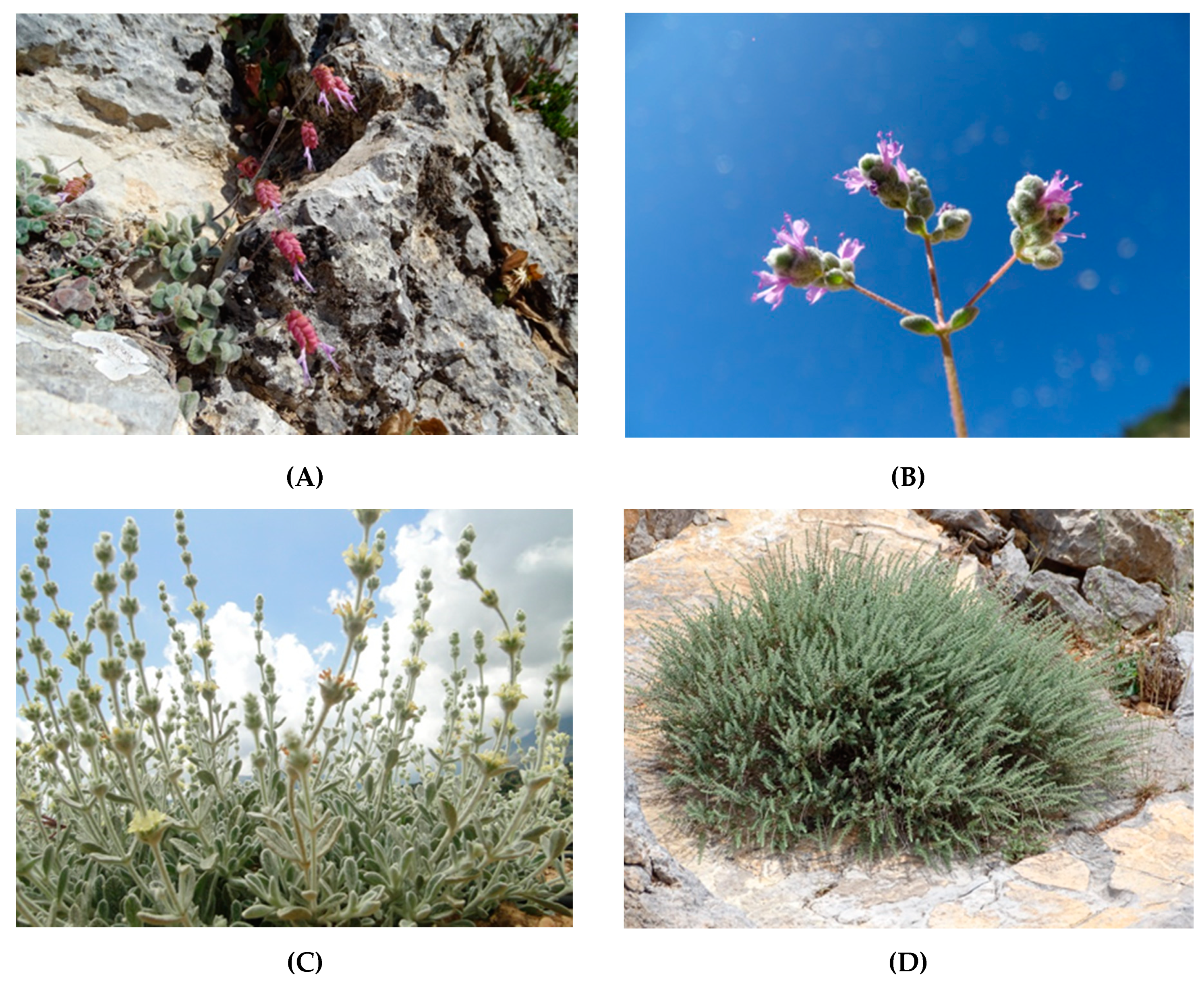



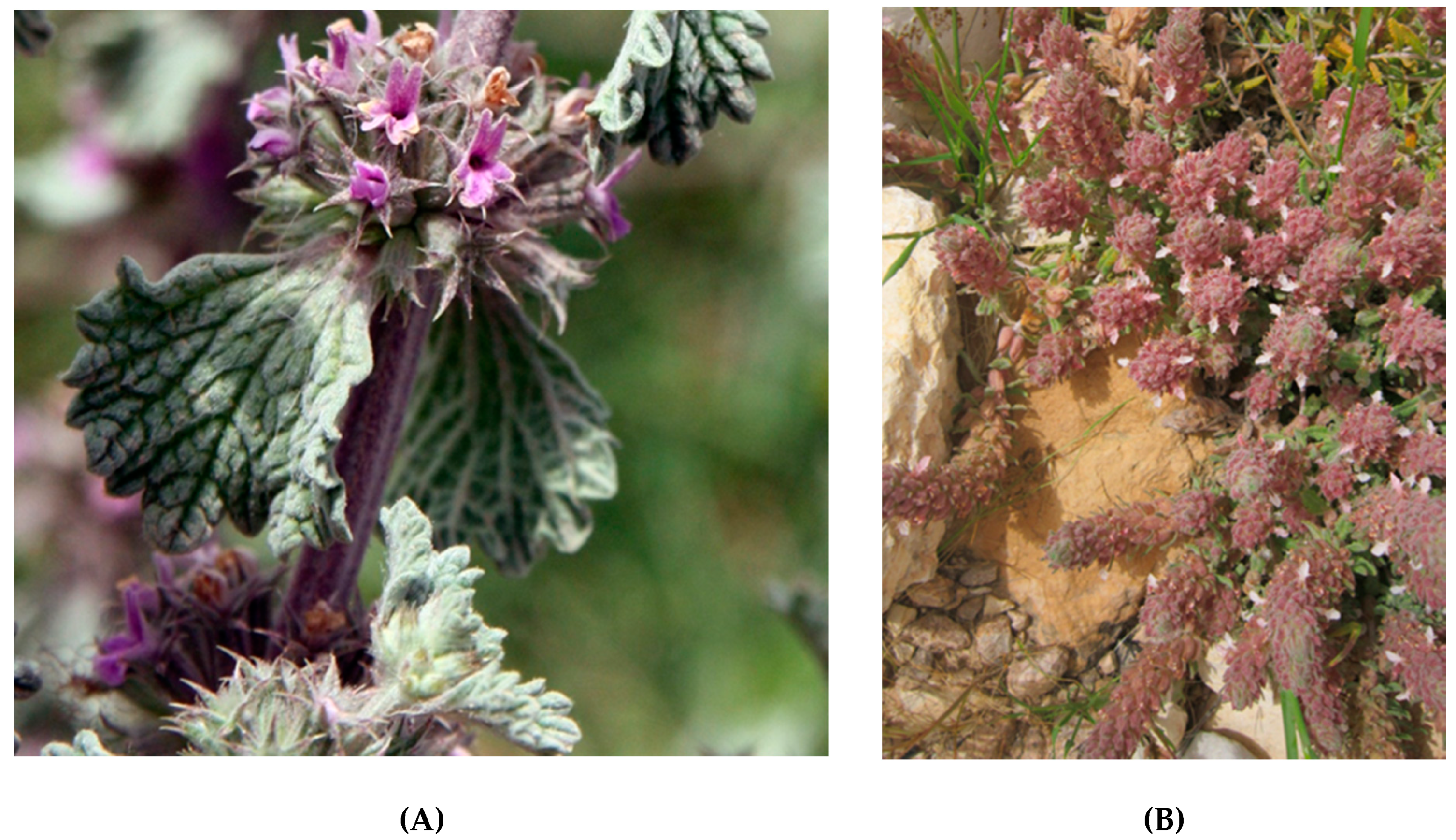
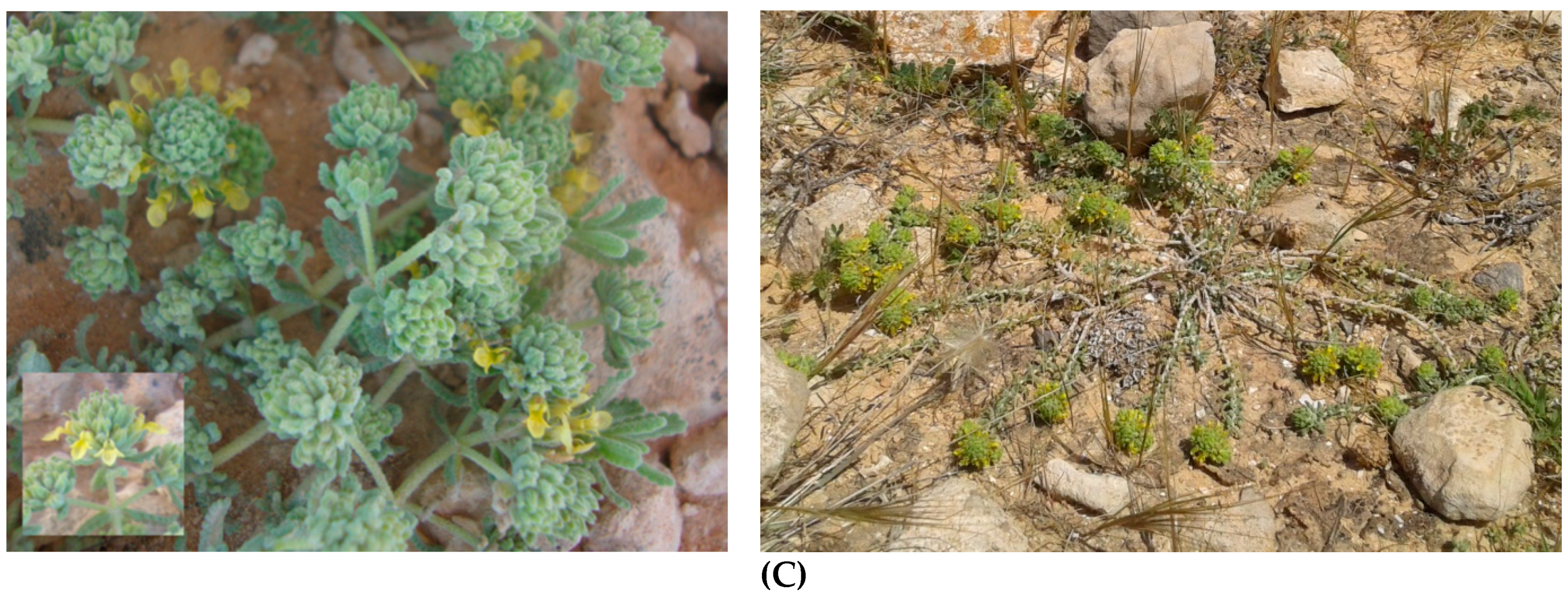
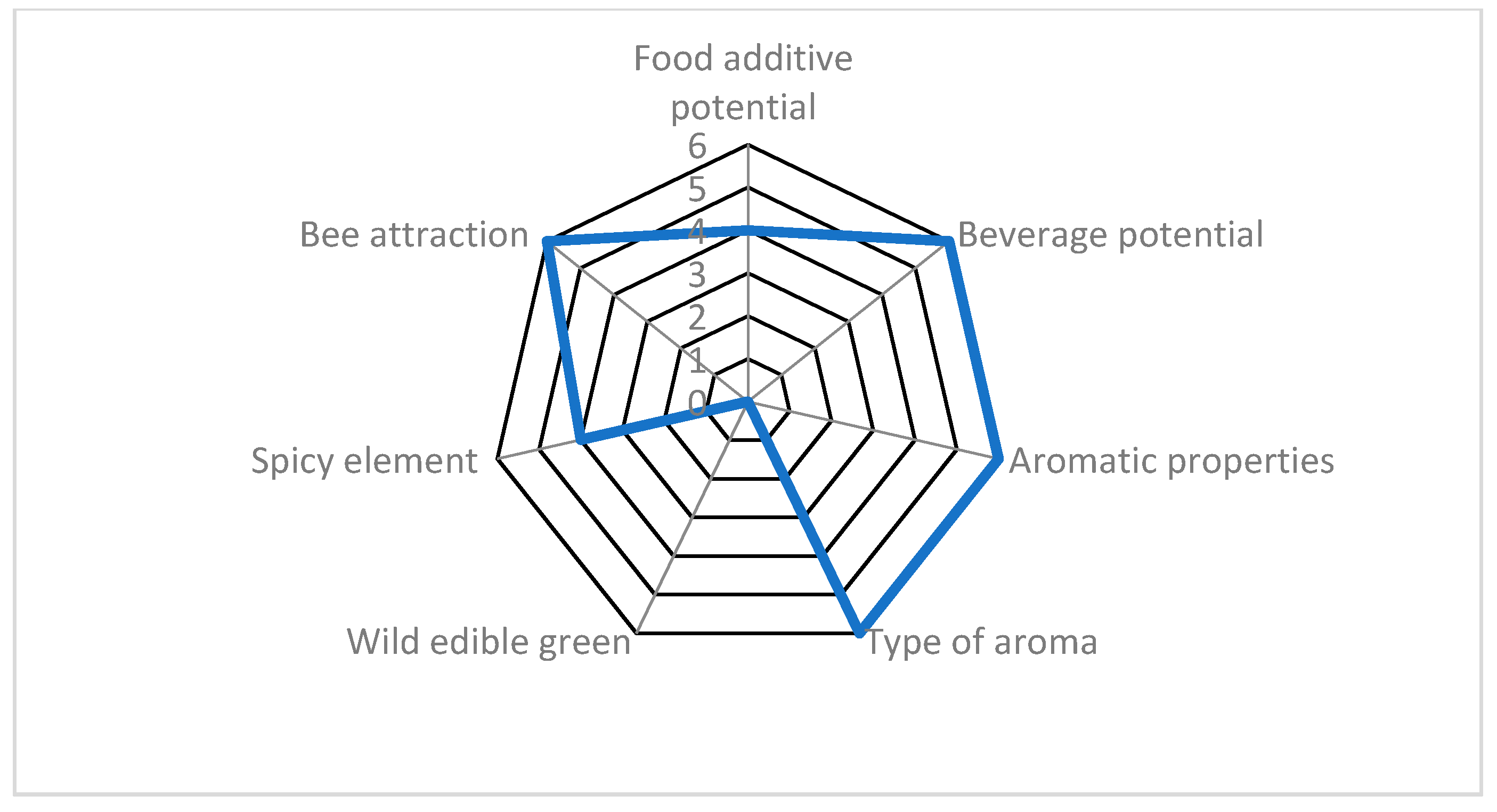
| Taxon | Agro-Alimentary Potential (I) | Sustainable Exploitation Feasibility (II) | Readiness Timescale (III) |
|---|---|---|---|
| Origanum dictamnus | 80.95% | 91.67% | Already achieved |
| Sideritis syriaca subsp. syriaca | 80.95% | 66.67% | Short-term (or achieved) |
| Origanum microphyllum | 80.95% | 52.78% | Medium-term |
| Attribute | Short Description | Score 0 | Score 1 | Score 2 | Score 3 | Score 4 | Score 5 | Score 6 | Possible Scores |
|---|---|---|---|---|---|---|---|---|---|
| Food additive potential | Use for alimentary or flavouring purposes | No | - | - | Under investigation | Possible | - | Yes | 0, 3, 4, 6 |
| Beverage potential | Use as tea infusion, tisane or decoction | No | - | - | Under investigation | Possible | - | Yes | 0, 3, 4, 6 |
| Aromatic properties | Perceived volatile constituents | No | Uncertain/Ambiguous | - | - | - | - | Yes | 0, 1, 6 |
| Type of aroma | Perceived basic aroma type | Bad or not smelling | Other | - | Indifferent/Light | Pungent | - | Pleasant | 0, 1, 3, 4, 6 |
| Wild edible green | Alimentary value as wild edible plant | No | Uncertain/Ambiguous | - | Under investigation | Possible | - | Yes | 0, 1, 3, 4, 6 |
| Spicy element | Savoury, flavouring and/or beneficial value | No | Uncertain/Ambiguous | - | Under investigation | Possible | - | Yes | 0, 1, 3, 4, 6 |
| Bee attraction | Apicultural nutritional value | No | Uncertain/Ambiguous | - | Under investigation | Possible | - | Yes | 0, 1, 3, 4, 6 |
Publisher’s Note: MDPI stays neutral with regard to jurisdictional claims in published maps and institutional affiliations. |
© 2021 by the authors. Licensee MDPI, Basel, Switzerland. This article is an open access article distributed under the terms and conditions of the Creative Commons Attribution (CC BY) license (https://creativecommons.org/licenses/by/4.0/).
Share and Cite
Libiad, M.; Khabbach, A.; El Haissoufi, M.; Anestis, I.; Lamchouri, F.; Bourgou, S.; Megdiche-Ksouri, W.; Ghrabi-Gammar, Z.; Greveniotis, V.; Tsiripidis, I.; et al. Agro-Alimentary Potential of the Neglected and Underutilized Local Endemic Plants of Crete (Greece), Rif-Mediterranean Coast of Morocco and Tunisia: Perspectives and Challenges. Plants 2021, 10, 1770. https://doi.org/10.3390/plants10091770
Libiad M, Khabbach A, El Haissoufi M, Anestis I, Lamchouri F, Bourgou S, Megdiche-Ksouri W, Ghrabi-Gammar Z, Greveniotis V, Tsiripidis I, et al. Agro-Alimentary Potential of the Neglected and Underutilized Local Endemic Plants of Crete (Greece), Rif-Mediterranean Coast of Morocco and Tunisia: Perspectives and Challenges. Plants. 2021; 10(9):1770. https://doi.org/10.3390/plants10091770
Chicago/Turabian StyleLibiad, Mohamed, Abdelmajid Khabbach, Mohamed El Haissoufi, Ioannis Anestis, Fatima Lamchouri, Soumaya Bourgou, Wided Megdiche-Ksouri, Zeineb Ghrabi-Gammar, Vasileios Greveniotis, Ioannis Tsiripidis, and et al. 2021. "Agro-Alimentary Potential of the Neglected and Underutilized Local Endemic Plants of Crete (Greece), Rif-Mediterranean Coast of Morocco and Tunisia: Perspectives and Challenges" Plants 10, no. 9: 1770. https://doi.org/10.3390/plants10091770
APA StyleLibiad, M., Khabbach, A., El Haissoufi, M., Anestis, I., Lamchouri, F., Bourgou, S., Megdiche-Ksouri, W., Ghrabi-Gammar, Z., Greveniotis, V., Tsiripidis, I., Dariotis, E., Tsiafouli, M. A., & Krigas, N. (2021). Agro-Alimentary Potential of the Neglected and Underutilized Local Endemic Plants of Crete (Greece), Rif-Mediterranean Coast of Morocco and Tunisia: Perspectives and Challenges. Plants, 10(9), 1770. https://doi.org/10.3390/plants10091770








